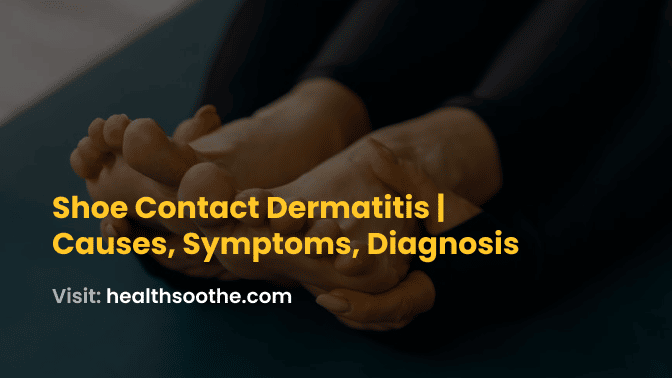Skin symptoms on the feet brought on by wearing shoes, boots, or sandals are known as shoe contact dermatitis. A kind of allergic contact dermatitis known as shoe contact dermatitis often develops when certain compounds (allergens) in your shoes create an allergic reaction in the skin on your feet. Manufacturing footwear involves the use of a wide variety of materials and chemicals.
Allergies may be brought on by chemicals contained in the leather or rubber used to make the footwear, by glues used to keep the shoe together, or by embellishments added to the shoe.
An immune system's or delayed hypersensitivity reaction to a tiny molecule (less than 500 daltons), or hapten, that comes into touch with a person's sensitive skin results in allergic contact dermatitis.
Sensitization, the process that results in the increase of an allergen-specific T cell population, is what causes the hapten to interact with a protein to cause the first or induction phase of allergic contact dermatitis. Re-exposure to the antigen causes dermatitis to form during the elicitation phase. 20% of cases of contact dermatitis are caused by allergic reactions, and allergens vary widely depending on region, individual habits, and hobbies. For example, quaternion-15 is permitted in the United States but not in Europe.
Causes of Shoe contact dermatitis
Rubber
- Chemicals called rubber accelerators are used to quicken the production of rubber. Rubber accelerators are included in almost all rubber compounds.
- Shoe dermatitis is most often brought on by rubber box-toe shoes and boots.
- In addition to them, rubber is also used to make slippers, boots, jandals, and flip-flop sandals.
- The outside leather, linings, and shoe uppers are all joined together using rubber cement.
Leather
- In sachets contained in shoe boxes, there is a strong allergy called dimethyl fumarate (DMF) 5. It stops leather shoe mould from growing, but it also penetrates the material. Numerous sachets labelled "Silica gel" also contain considerable levels of dimethyl fumarate, according to Lamas et al. 6's warning (DMF). The importation of goods contaminated with DMF, such as couches, shoes, and toys (with a maximum allowable concentration of 0.1 mg/kg), was prohibited by a communication 7 released by the European Commission in March 2009. They suggested seizing tainted items off the market and warning customers about the dangers.
- Chromates used in leather tanning, such as potassium dichromate, may cause problems, especially if the feet perspire since perspiration leaches off the chromates.
- In "white child" and "young bucks," formaldehyde is used in the tanning of white leather shoes.
Additional factors
- Colourants, especially paraphenylenediamine
- Glues like colophony and para-tertiary butyl-phenol formaldehyde resin
- buckles or other ornaments made of metal that have direct skin contact. Cobalt and nickel are also frequent allergies.
Shoe contact dermatitis prevention
The easiest strategy to avoid issues if you have shoe contact dermatitis is to stay away from any footwear that contains the allergen you are sensitive to.
You may take the following precautions to lessen the effects of shoe contact dermatitis:
- utilising antiperspirants to reduce foot perspiration
- Put on shoes with a vegetable tan.
- Swap out your rubber insoles with a foam sole made of urethane foam.
- Avoid keeping shoes in boxes with DMF sachets and routinely air your shoes.
For example, if you are very sensitive to a particular allergy, your dermatologist may have more special suggestions.
Shoe contact dermatitis symptoms
The top of the big toe is typically where shoe contact dermatitis starts, then it spreads to the upper surfaces of the foot. The sole, the sides of the foot and heels, and the legs might also develop dermatitis.
Swelling, redness, blisters or skin splits, burning, itching, and discomfort are all possible signs of contact allergic dermatitis. The skin on the feet is repeatedly exposed to a specific allergen found in the shoe, which can cause an allergy to develop over time. After months or years of exposure, it is common to develop an allergy to a substance, though.
Shoe contact dermatitis diagnosis
The clinical presentation, a positive patch test, a history and a physical examination, together with other factors, are often used to make the diagnosis of allergic contact dermatitis. However, shoe contact dermatitis is sometimes difficult to diagnose since a few other conditions need to be checked out. These consist of:
- bacterial infection
- fungal infection (tinea pedis, athlete’s foot)
- atopic dermatitis
- irritant contact dermatitis due to occlusion, moisture and friction
- Juvenile plantar dermatosis
- pompholyx
- psoriasis
- lichen planus
- allergic contact dermatitis caused by something other than shoes (e.g. sock fabric, cosmetic product).
Due to the many possible allergens that might be present in the shoe, a diagnosis by doing particular allergy tests (patch tests) may require testing against several distinct compounds. Making the right diagnosis requires patch testing using the patient's shoes as well as a shoe "screening tray" of common additions and chemicals.
A skin biopsy of the afflicted region of the skin will often show spongiosis if additional analysis is necessary. However, it is unclear whether this discovery would make it easier to distinguish allergic contact dermatitis from other eczematous dermatologic conditions.
Shoe contact dermatitis treatment
All patients with suspected or confirmed allergic contact dermatitis should be informed of the fact that the only effective therapy for the condition is the identification and elimination of the offending substance. Once the harmful allergen is eliminated, shoe contact dermatitis should resolve quickly.
Unless the allergy can be eliminated, this will result in never being able to wear the problematic shoes again. By substituting a non-nickel buckle, for instance, a nickel allergy might be treated. Choosing things made of leather that has been vegetable-tanned can help you prevent chromate allergy.
Itching, swelling, and redness may be managed with over-the-counter lotions and ointments containing modest topical steroids, such as hydrocortisone. If the skin develops blisters, is painful, or gets infected, a prescription topical steroid and antibiotic medicine may be needed in more severe situations.
Use patch testing to determine the cause of persistent or recalcitrant allergic contact dermatitis.
The right chemicals must be chosen for testing, the patient must be counselled about the findings of the patch test, and the test must be positive for the relevant allergens. A "safe list" of goods that do not contain the patient's allergens may also be created using the North American Contact Dermatitis Group Contact Allergen Management Program. Systemic treatment may be required if allergens cannot be avoided.
Conclusion:
Foot dermatitis in children and adults is often brought on by allergic contact dermatitis triggered by footwear. When an allergic cause is thought to exist, people with foot dermatitis should be referred for patch testing. Remember we are always available to you.




